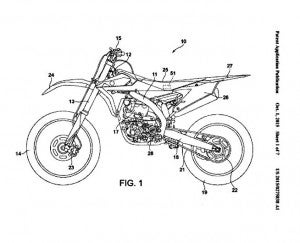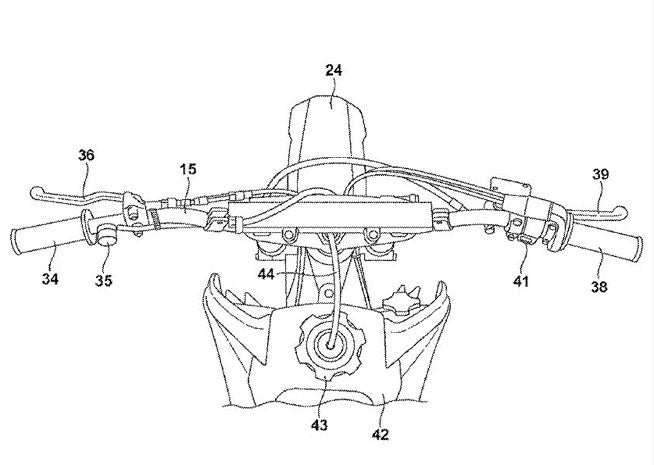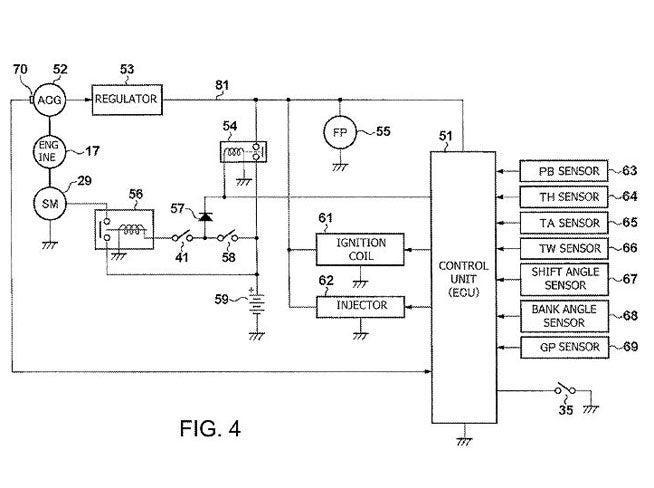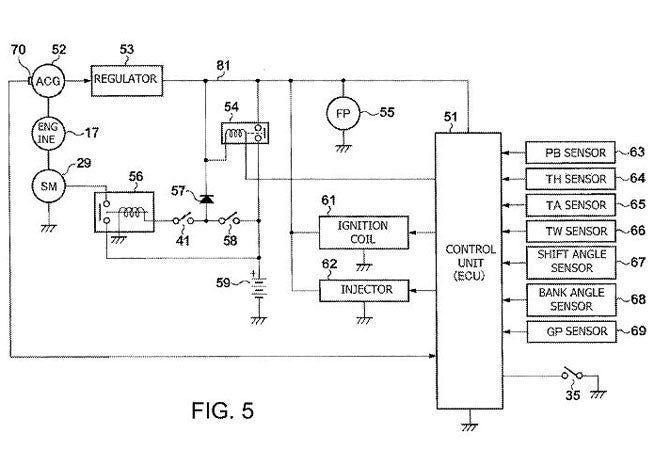U.S. Patent Office publishes an application and curious drawings for an electric starter and, maybe, a DOHC engine for Honda CRF motocrossers.
Props to our Motorcycle.com brother, Dennis Chung, for passing along word that the U.S. Patent office has published technical drawings for what appears to be a new Honda CRF motocross motorcycle with an electric start and, possibly, a double overhead cam engine design, but things get a little weird when it comes to the technical drawings that have been published.
The patent, filed on March 19, was for the electric-start device, which was invented by Japanese engineer Hitoshi Tsusaka. The patent information specifically states that it is for:
“An electricity supply devices that reduces delay in starting an engine. A vehicle includes a starter motor for starting an engine, a start magnet and breaking connection between the starter motor and a battery, a fuel pump and a control unit, controlling fuel injection and ignition timing of the engine. An electricity supply device of the vehicle includes: a main relay making and breaking connection between a load of the vehicle, the load not including the starter motor, the start magnet, and the battery; a clutch switch connected to the battery, and set in conducting state when a clutch lever is gripped; a start switch connected between the clutch switch and a coil of the start magnet; and a diode allowing a current to flow from a point of connection between the clutch switch and a start switch to a coil of the main relay.”
 However, the technical drawings also clearly show a double overhead cam engine with a rearward-exiting exhaust system, meaning that the cylinder head has been flipped 180 degrees. The basic design was first introduced on an off-road motorcycle by bicycle manufacturer Cannondale in 2001 in a costly and ill-fated attempt to develop competitive 450cc motocross/off-road motorcycles and ATVs; the Cannondale design also featured electric start. More recently, Yamaha revived the design on its fifth-generation YZ450F in 2010 and also introduced it on the class-conquering YZ250 in 2014. Lo and behold, we learned that the two drawings of the actual motorcycle are, indeed, of a Yamaha YZ450F, not a Honda. This is weirdness on a grand scale. According to our patent expert, Chung, the paperwork clearly deals with Honda’s patent, yet the Yamaha motorcycle drawings are used. We have placed a phone call to Honda to clear this up, although we will be surprised if they don’t remain mum on the subject. We have also heard from a trustworthy source close to the company that the DOHC engine is a reality for 2017.
However, the technical drawings also clearly show a double overhead cam engine with a rearward-exiting exhaust system, meaning that the cylinder head has been flipped 180 degrees. The basic design was first introduced on an off-road motorcycle by bicycle manufacturer Cannondale in 2001 in a costly and ill-fated attempt to develop competitive 450cc motocross/off-road motorcycles and ATVs; the Cannondale design also featured electric start. More recently, Yamaha revived the design on its fifth-generation YZ450F in 2010 and also introduced it on the class-conquering YZ250 in 2014. Lo and behold, we learned that the two drawings of the actual motorcycle are, indeed, of a Yamaha YZ450F, not a Honda. This is weirdness on a grand scale. According to our patent expert, Chung, the paperwork clearly deals with Honda’s patent, yet the Yamaha motorcycle drawings are used. We have placed a phone call to Honda to clear this up, although we will be surprised if they don’t remain mum on the subject. We have also heard from a trustworthy source close to the company that the DOHC engine is a reality for 2017.
We do know that Honda has experimented with the DOHC design as a prototype in its factory Dakar Rally machines recently, but the move to a DOHC engine would still come as somewhat of a surprise to us. While DOHC designs are generally lauded for their ability to more easily make power in a specified rpm range because separating the intake and exhaust cams allows them to be advanced or retarded individually, the tradeoff has always been increased top-end weight and more reciprocating weight up high in the engine. Obviously, Yamaha, Kawasaki and Suzuki have all developed competitive 450s using the design, but Honda’s Unicam engine has proven itself to be equally competitive against the DOHC engines of its competition in both the 450cc and 250cc classes, and KTM’s SOHC SX450-F proved to be more than capable of winning the Lucas Oil Pro Motocross Championship with Ryan Dungey in 2015. Moving to a DOHC design would make more sense in the 250cc class, where manufacturers continue to push for ever-increasing power levels with a lot less displacement than a 450.
From a technical standpoint, we could understand the move to the flipped cylinder head if Honda does indeed jump into the DOHC fray. Yamaha has long claimed that the reason for its reversed cylinder head has to do with its potential to reduce air intake restrictions and provide a much straighter shot into the intake tract. Yamaha felt that it had reached the point of diminishing returns with the conventional exhaust-forward cylinder head configuration. It is far easier, they say, to make power with the cylinder head flipped. Perhaps Honda feels the same way, perhaps not, but it is hard to make any concrete conclusions about whether any 2017 Honda CRFs will be SOHC or DOHC based upon these drawings.
So, it will be interesting to see if and when Honda puts this particular engine configuration into production, but it does appear that one or both CRFs will have electric start in the forseeable future.



 Your Privacy Choices
Your Privacy Choices